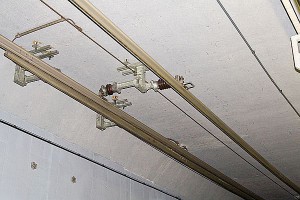Rigid Catenary (or Overhead Contact System)
The rigid catenary is an Overhead Contact System (OCS) that can replace, with many advantages, the contact wire with sustentation wire, the third rail or the suspended bimetallic T-rail.
It is formed by an aluminium alloy profile, which accommodates the copper contact wire, with a great cross section for the current that allows operative OCS voltages from 750 to 1.500 V, without any feeding supply. It has been also installed in lines with a feeding supply of 25 KV.
Rigid catenary system is a new power supply mode of electrification railway, comparing with the traditional flexible catenary system, it has below advantages.
1- more capability of current carrying
With large cross section current bar profile clamping contact wire, current bar profile and contact wire clamped in the draw-back collet current bar profile can permit high level current passing. Further more it can effectively reduce the radiation problem which caused by high level current.
2- No risk of breaking-off, more security
As there is no traction stress, it allows more contact wire wear without risk of breaking-off in rigid catenary system, the only limitation is that the pantograph can not touch the current bar profile.
3- Easy operation and maintenance
As the contact wire allows more wear and its installation and replacing is easy in rigid catenary system, the maintenance cost is greatly reduced. Periodical control of the current bar profile connectors tightening and cleaning up of the isolators are the only maintenance operations to be carried out
4- less tunnel clearance, less construction cost
Rigid catenary system reduces great tunnel clearance against standard catenary system, so the construction cost is greatly reduced.
[...]









